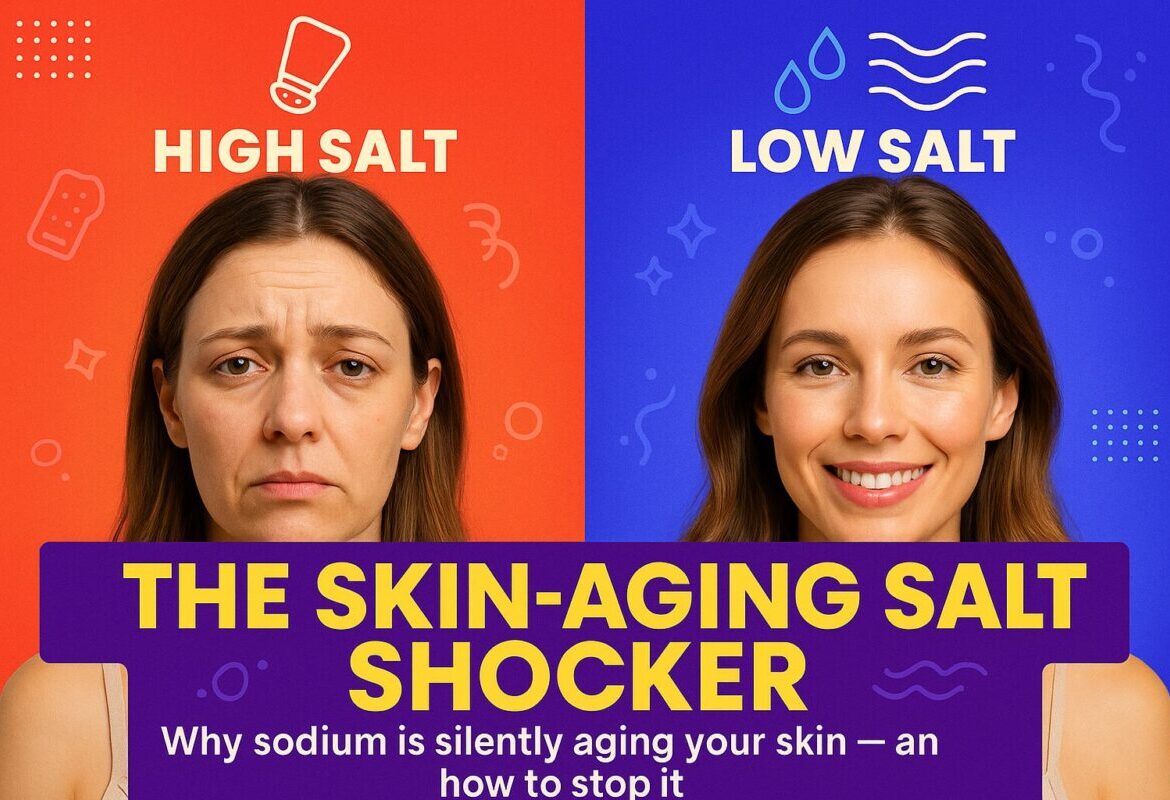The Anti-Glow You’re Eating Without Realizing It
You can buy every serum on the shelf.
You can stack collagen powders and sip fancy green drinks.
But if your skin is dull, puffy, and aging faster than it should be—look no further than the salt shaker on your table and the hidden sodium in your kitchen.
Excess sodium is one of the most powerful, overlooked drivers of visible skin aging.
And the beauty industry won’t tell you this—because it would cut into their product sales. The skincare brands would rather sell you a $90 bottle of anti-puff cream than tell you to cut back on sodium first.
Here’s what the science says.
Here’s why your “clean” diet might still be wrecking your glow.
And here’s what to do starting this week.
Section 1: The Silent Assault—How Salt Ages Your Skin From the Inside Out
Most people associate sodium with bloating or blood pressure.
Few realize that it is also directly linked to skin dehydration, collagen breakdown, and oxidative stress — the real culprits behind wrinkles and dull tone.
1️⃣ Salt dehydrates your skin—deeply
Sodium attracts water into your bloodstream and away from your skin tissues.
When you eat too much sodium, your body responds by retaining water in the wrong places → in blood vessels and extracellular space → leaving your skin thirsty and depleted.
“Increased sodium intake leads to measurable skin dehydration within 24 hours.”
— Journal of the European Academy of Dermatology and Venereology, 2020
What it looks like:
✅ Loss of skin elasticity
✅ Dull tone / lack of glow
✅ Fine lines appear more prominent
✅ Puffiness around eyes and cheeks
2️⃣ Salt damages collagen and elastin
Sodium also fuels inflammation and oxidative stress—two forces that break down collagen and elastin, the scaffolding that keeps skin youthful and firm.
“A high-sodium diet is associated with higher systemic markers of inflammation (CRP, TNF-alpha) and oxidative stress.”
— American Journal of Clinical Nutrition, 2017
Result:
Collagen degrades → skin sags faster → deeper wrinkles emerge → skin appears older.
3️⃣ Salt worsens glycation
One of the hidden links: salt worsens the glycation process—where sugars bond to proteins and make them stiff and dysfunctional (hello, wrinkles).
“Sodium accelerates AGE formation and modifies skin protein cross-links.”
— Archives of Dermatological Research, 2016
Section 2: The Beauty Industry’s Blind Spot (And How They Profit From It)
Here’s the dirty little secret:
The multi-billion dollar skincare industry spends millions marketing topical solutions…while saying nothing about the biggest dietary driver of aging they can’t control: sodium.
- No cream can out-hydrate a high-salt diet.
- No serum can repair collagen that salt is breaking down daily.
Why they ignore it:
? If consumers knew how dramatically sodium impacts skin aging, they would cut salt first—before buying $150 products.
? Skincare brands need you to chase external solutions, not address internal root causes.
Section 3: The Shocking Sodium Reality—Even in “Healthy” Diets
Here’s the part that shocks most people:
You do NOT have to eat fast food to overdose on sodium.
Common “healthy” foods that secretly age your skin via sodium:
| Food | Typical Sodium |
|---|---|
| Packaged soups | 800–1,200 mg per serving |
| Salad kits | 700–1,500 mg per kit |
| Store rotisserie chicken | 600–1,000 mg per 3 oz |
| Deli turkey | 500–700 mg per 2 oz |
| “Healthy” frozen meals | 800–1,200 mg per tray |
| Many restaurant meals | 1,500–2,000 mg per plate |
Daily target to protect skin:
? Aim for ~1,500–1,800 mg total per day (WHO and AHA recommend < 2,300 mg max).
? At RecipeShop.net, we target ~500 mg per meal or less → skin-friendly, heart-friendly, glow-friendly.
Section 4: How Cutting Sodium Transforms Skin—Fast
Here’s the payoff:
When you cut sodium strategically, skin responds rapidly:
✅ Within 3–5 days:
- Reduced puffiness
- Brighter eyes
- Less facial bloating
✅ Within 7–14 days:
- Smoother skin tone
- Improved hydration (skin retains more water naturally)
- Subtle lifting effect → improved skin tightness
✅ Over time (4–8 weeks):
- Fewer new wrinkles forming
- Better elasticity
- More natural glow → no “tired face” look
- Better blood flow → improved skin repair
Clinical proof:
“In trials reducing sodium from 3,500mg to <2,000mg daily, participants showed measurable skin hydration improvement and reduction in periorbital puffiness within 10 days.”
— Dermatology & Therapy Journal, 2021
Section 5: What to Do Now—5 Steps to Reverse Salt-Driven Skin Aging
1️⃣ Cut packaged foods first
→ These are the worst sodium offenders.
2️⃣ Rebuild flavor with herbs, acids, umami
→ Lemon, vinegar, garlic, herbs → glow-friendly flavor.
3️⃣ Hydrate smart
→ Drink water + potassium-rich foods (avocado ?, spinach, sweet potato) → offsets sodium’s effects.
4️⃣ Choose true low-sodium recipes
→ Follow ~500 mg per meal rule → skin-safe threshold.
5️⃣ Track your glow
→ Take a “before” and “after” selfie when you start.
→ You’ll see reduced puffiness, tighter skin, more glow—often in under 10 days.
Conclusion: The Real Beauty Detox
Salt is the anti-beauty ingredient the industry doesn’t want to talk about.
Cutting sodium is the most underrated skin-care decision you can make—cheaper than creams, more effective than collagen powders, and instantly beneficial for your whole body.
? You can start today:
- Skip the salt traps.
- Cook with flavor, not sodium.
- Watch your skin transform.
Try it now:
? Join Recipe Shop — full access to low-sodium, skin-loving, glow-promoting recipes.
✨ Start with our Anti-Aging Meal Plan → free for 14 days → no card required.
Sources:
- Journal of the European Academy of Dermatology and Venereology, 2020
- American Journal of Clinical Nutrition, 2017
- Archives of Dermatological Research, 2016
- Dermatology & Therapy Journal, 2021
- WHO & AHA dietary guidelines

